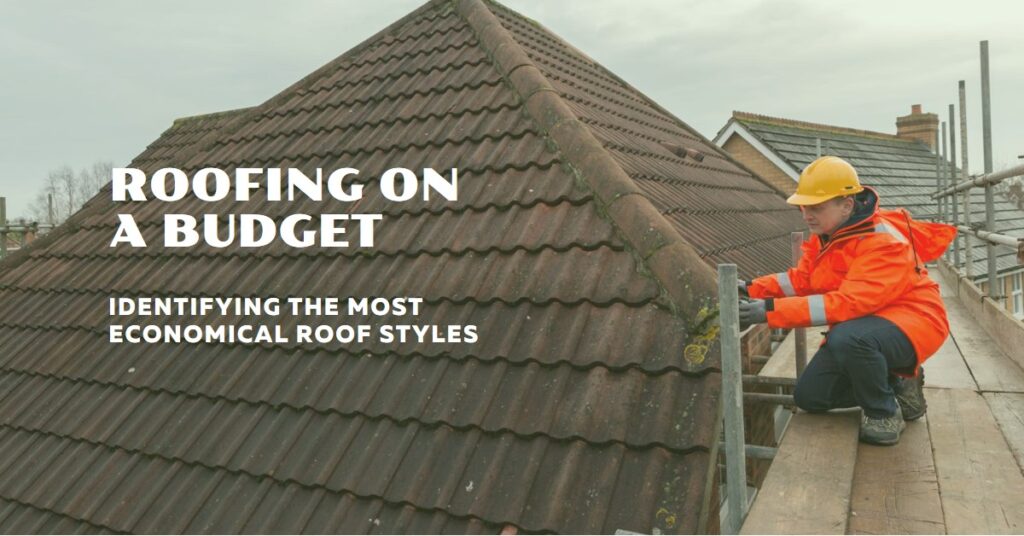When weighing cost and value in roofing decisions, gable, hip, and flat roofs emerge as the most cost-effective options because of their simple designs and reduced installation expenses.

On the other hand, while styles such as gambrel, mansard, and A-frame require a larger upfront cost, they provide distinct aesthetic and practical benefits, potentially increasing a property’s overall value.
As a shield against nature’s elements and a significant aesthetic determiner, the roof places homeowners at the crossroads of design desires, functionality, and budgetary considerations.
Hence, understanding this balance is critical to making a cost-effective and value-enhancing decision, and this exploration into diverse roof styles aims to illuminate their cost and value dynamics.
Factors Influencing Roofing Costs
Every roofing choice comes with its own set of financial implications. Let’s break down the factors that play a pivotal role:
Material Costs:
The choice of roofing material is often the most significant cost factor. Common materials include asphalt, which is relatively affordable; metal, which offers longevity but at a higher price point; wood, known for its natural beauty but requires maintenance; and tile, which stands out for its durability and distinctive look but can be costly.
Installation Complexity:
A complex roof design can be stunning but means more labor, time, and potential challenges. This complexity invariably increases installation costs.
Maintenance Requirements:
Some roofs, like cedar ones, require frequent maintenance to maintain beauty and function. Others, like metal roofs, demand less upkeep. It’s essential to consider these ongoing costs when considering the overall expenditure.
Longevity and Durability:
Investing in a durable roof might mean higher upfront costs, but the long-term savings in repairs and potential replacements can make it a value-rich choice.
Economical Roof Styles Overview
When it comes to roofing on a budget without compromising on quality, some styles stand out:
Gable Roofs:
Gable roofs are among the most common and economical, characterized by their triangular shape. Their design simplicity leads to lower installation costs. The steep pitch allows easy water runoff, reducing potential risks of water damage.
Hip Roofs:
With slopes on all four sides, hip roofs are sturdier than gable roofs, making them a favorite in regions with high winds or hurricanes. While they might be slightly pricier than gable roofs, they offer increased stability and durability.
Flat Roofs:
Especially common in commercial buildings, flat roofs are typically more affordable due to their straightforward design. However, they require vigilant maintenance to avoid water pooling and potential damage, especially in regions prone to heavy rainfall.
Value-added Roof Styles
Certain roof styles, while potentially commanding higher initial costs, bring unparalleled aesthetic and functional value to a property:
Gambrel and Mansard Roofs:
These styles feature two distinct slopes, with the lower slope being steeper. While installation might be pricier, they open the door to additional living or storage space, making them favorites for homes with attics or garrets.
Saltbox Roofs:
With their unique asymmetrical design, saltbox roofs bring a touch of New England charm. The design, while offering character, also provides functionality regarding water runoff.
A-frame Roofs:
A-frame design is a staple in cottages, chalets, and churches. While potentially more expensive due to the extensive coverage, they offer a distinctive look and solid protection against the elements.
The Long-term Perspective
When evaluating cost versus value, looking beyond just the installation phase is crucial. Consider energy efficiency—certain materials and designs can provide insulation benefits, leading to long-term savings on energy bills.
Moreover, a high-quality roof can enhance property value, making it an attractive proposition to future buyers. And, of course, less frequent maintenance or repair needs over the roof’s lifespan can translate to significant savings.
Making an Informed Decision
Choosing a roof is more than picking the cheapest or aesthetically pleasing design. It’s about understanding your home’s needs and the climatic conditions of your region and aligning these with your budget.
Consulting with roofing professionals can offer insights into what would work best for your specific circumstances, ensuring you get the best bang for your buck.
After all, a roof isn’t just a protective cover—it’s an investment in your home’s future.
